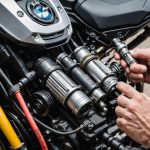Charging Habits for Extended Battery Life
To maximise battery life, developing effective charging strategies is crucial, particularly for hybrids and electric vehicles like plug-in hybrids. One key aspect is optimal charging times. Aim to charge during off-peak hours when electricity demand and prices are lower. This not only saves money but also helps maintain the health of your battery.
Equally important is the frequency of charging. Consistent charging avoids deep battery discharges, which can strain battery life. Plug-in hybrids often benefit from this gentle charging regimen, as they rely heavily on electricity.
This might interest you : Top Strategies to Minimize Interior Vibrations in Luxury British Automobiles
Selecting the correct charger is vital for battery maintenance. Using a charger that matches your vehicle’s specifications prevents overheating and potential damage, ensuring a long battery life. Therefore, always follow the manufacturer’s recommendations for charger type and voltage.
Additionally, avoiding full discharges of your battery extends its longevity. Keeping the battery level between 20% and 80% reduces stress on the battery cells and optimises overall health. By tailoring your charging habits to these guidelines, you not only prolong battery life but also enhance the efficiency and reliability of your plug-in hybrid.
Also read : Exploring the Pros and Cons of Nitrogen-Filled Tires for British Sports Cars
Maintenance Tips for Plug-In Hybrids
Maintaining a plug-in hybrid vehicle involves more than just regular oil changes—it’s about ensuring the health of hybrid systems. Regular software updates are crucial. These updates often improve vehicle performance and energy efficiency while also addressing any potential issues before they become serious. Additionally, ensuring that diagnostics are up-to-date assists in spotting any irregularities in vehicle operations early on.
A significant component of hybrid vehicle health is paying attention to the cooling system. The cooling system helps manage the temperature of the engine and battery. Overheating can reduce battery lifespan and performance. Therefore, checking coolant levels and condition frequently is advisable.
Lastly, monitoring the battery health status cannot be overstated. A well-maintained battery ensures optimal performance, reliability, and longevity of your hybrid vehicle. Regular inspections can help identify potential problems before they escalate. Most modern hybrids offer integrated systems to check battery status, so familiarizing oneself with these tools can be beneficial.
Through consistent battery care, software updates, and cooling system checks, you can significantly enhance your hybrid’s longevity and efficiency.
Driving Techniques to Increase Battery Efficiency
Mastering energy-efficient driving requires a keen understanding of how your actions impact both fuel savings and overall performance. Adopting smooth acceleration and braking techniques is crucial. Rapid acceleration and sudden stops drain the battery, reducing efficiency. Instead, try to maintain a steady pace and gradually accelerate or decelerate. This not only preserves battery life but also improves the driving experience.
Another key aspect is using regenerative braking effectively. Unlike traditional braking, regenerative braking returns energy to the battery, extending its charge. To optimise this, anticipate stops and slow down gradually. This method captures more energy, enhancing the vehicle’s range over time.
Moreover, selecting the appropriate driving modes significantly influences battery efficiency. Hybrid vehicles often feature multiple modes tailored for different scenarios. For instance:
- Eco Mode: Prioritises efficiency, reducing energy consumption by limiting acceleration and other power-hungry functions.
- Sport Mode: Enhances performance but increases energy usage, suitable for short sprints only.
Proper utilisation of these modes not only offers tailored driving experiences but also maximises fuel savings. Understanding these hybrid driving tips can lead to a more efficient and enjoyable driving journey.
Common Misconceptions About Battery Care
In the world of Battery myths and misinformation, it’s easy to become confused about best practices. Let’s address some common misconceptions.
Myth: Battery lifespan significantly diminishes if not fully charged or discharged. This traditional view often arises from outdated “battery memory effects.” However, modern lithium-ion batteries used in most devices do not suffer from such effects. In fact, partial charges are perfectly fine and can sometimes be more beneficial than complete cycles.
Another prevalent misconception involves plug-in hybrid vehicles. Many people believe these need to be drained completely before recharging. In practice, this can actually harm your vehicle’s battery over time.
Temperature also significantly impacts battery health. Extreme hot or cold conditions can degrade a battery’s lifespan. Keeping your device at a stable temperature enhances longevity, while fluctuations can lead to reduced performance.
For plug-in hybrid education, an important takeaway is understanding how regular charging, without waiting for full discharge, can maintain optimal battery health. It’s crucial to base battery care on modern understandings and not obsolete guidelines. Dispelling these myths helps ensure your devices and vehicles remain efficient, reliable, and long-lasting.
Comparative Analysis of Plug-In Hybrid Models
In exploring the hybrid performance of popular plug-in hybrid models, several aspects stand out. Battery longevity is a crucial consideration for consumers, as it directly impacts the vehicle’s efficiency and cost-effectiveness over time. Generally, plug-in hybrids offer a blend of electric and gasoline power, which extends their range and flexibility.
When examining vehicle comparisons, it’s noticeable that models vary in terms of battery warranties. These warranties often serve as a measure of the manufacturer’s confidence in their battery’s durability. For instance, some manufacturers offer up to eight years or 100,000 miles, assuring buyers of long-term reliability. However, it’s essential to read the fine print as conditions can vary.
Consumer feedback provides valuable insights into the real-world performance of these hybrids. Many users appreciate the balance between electric-only travel and conventional fuel backup, highlighting reduced fuel expenses and lower emissions. Nonetheless, some feedback points to concerns about battery longevity, especially in extreme weather conditions that may affect overall hybrid performance.
Understanding these factors is vital for any potential buyer to make a more informed decision about their next plug-in hybrid purchase.
Conclusion and Call to Action
Reflecting on the top strategies discussed throughout the article, it’s clear that effective community engagement plays a crucial role in implementing these solutions. By actively participating in community forums or discussion groups, you can both share and learn from diverse experiences, fostering a deeper understanding and broadening your perspective on problem-solving methods. This community engagement ensures that strategies are not only theoretical but are tested and refined in real-world scenarios.
Take the next steps on your journey by integrating these strategies into your personal or professional life. Engage with others who are also exploring these methods, and don’t hesitate to share your own challenges and successes. By doing so, you contribute to a collective knowledge base that benefits everyone.
To aid in this, we encourage you to explore additional resources. While we’ve provided a summary here, further reading can extend your understanding and offer new insights. Remember, the journey towards improvement is continuous, and every personal experience shared adds value to the community and helps refine these strategies further.











